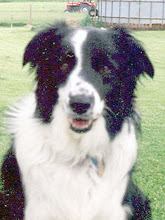I sowed pea and lettuce seeds on Sunday, March 8.
It was sunny and sweatshirt weather. Coronavirus was in the news, but people were still moving about--and my parents, including my father who is assisted living, came out to the farm for dinner.
Before planting, I looked on the seed packets for the days to maturity. Sometime in May, I should be eating peas and lettuce. I'll have to harvest them between dog trials, I thought, noting my busy spring sheepdog trial schedule.
Temperatures dropped and rains came after that initial planting. For days, the soil looked as barren as it did on that early March day.
On Wednesday, March 18, I sowed more peas, lettuce, onions and radish seed in what I now called my Victory Garden.
The coronavirus was spreading, and the Ohio governor had ordered the closing of schools and restaurants. The primary election was postponed. I could no longer visit my father.
Each day, I checked for a sign of green in the garden. Each day, I found none.
On Friday, March 27, I again sowed onions, peas, lettuce and spinach seeds. Ohio residents were now under a Stay at Home order as the coronavirus pandemic spread around the United States and the world. The week's news was filled with stories about the nosediving stock market, the trillion dollar stimulus package, record unemployment and lack of medical supplies. Flattening the curve and social distancing were now part of my vocabulary. Early spring sheepdog trials were canceled.
The rains came Friday afternoon, and sprouts from those seeds from the March 8 and March 18 plantings peeked through the soil.
I don't know what the coming weeks and months will bring, but I have seeds and I have a garden, and when the sun shines, I will continue sowing seeds and looking for those glimmers of green.
Sunday, March 29, 2020
Sunday, March 8, 2020
Sheep Rolling
Sixty degrees and sunshine in March is a reason for celebration in Ohio.
After weeks of gray, rain and mud, I welcomed warmth and light, and made an outdoor chore list that was long and impossible to complete in a day.
I didn't care.
The sun was shining.
Riding the Gator, I went from pasture to pasture, loading up gates and panels that weren't needed. Some were being used as windblocks, some as training obstacles for sheepdog training. Lambing season is two weeks away, and I needed all of them to construct lambing pens.
While working, I delighted in watching the sheep graze and sun themselves on the hillside. One ewe, though, caught my attention. She was lying away from the others, and something didn't look right.
I walked out to investigate.
She was lying on her back with 4 of her legs straight up in the air.
Was she dead?
She moved her head and I saw the whites of her eyes.
Not dead. Dying? She peddled her feet, but remained flat on her back.
Cast.
Sometime over the years, I'd read about cast sheep. Sometimes, they get stuck on their back and can't get up. If not helped, they'll likely suffocate and die.
This was not a small ewe. She was large, hefty and quite pregnant.
Sometimes, you don't think, and you just do. So, I knelt beside her, reached over to the top of her shoulder and rolled her onto her side.
She shook her head, struggled to her feet, walked a few steps and gave me the look that said, "Thank you, now go away."
And I did. But I was smiling, because I'd just rolled over a sheep.
Tuesday, March 3, 2020
Sheep Math
When asked how many lambs we're expecting this year, I pause.
It shouldn't be a difficult question. We consistently have a 200 percent lambing rate. That means if we breed 10 ewes, we expect 20 lambs. Most ewes have twins; a few may have a single or a lamb may die; others have triplets. It averages out to two lambs per ewe.
So, to answer the question, all I do is multiply the number of bred ewes by two.
And, that's where it gets tricky.
I selected 15 ewes for breeding in the fall, marked their backs with a grease marker, and turned them out with the ram. The rest of the flock (the extremely young and the cull ewes), I kept separate for sheepdog training.
A few weeks after doing this, I went to a dog trial. Some unauthorized mingling went on while I was away. Upon finding three delinquents with the ram, I marked them. Past experience tells me they're most likely bred. Because grease marks fade, I re-marked the ewes several times through winter.
Pregnant ewes need extra nutrition during their last 7 weeks of pregnancy. So, last month I separated the "marked" sheep from the unbred ewes. Nineteen ewes looked at my, licking their lips in anticipation of corn and second-cutting hay.
Where did the extra ewe come from?
In the low winter light, did I mistake dirt for grease markings and mark an extra ewe?
Or, had a clever ewe marked herself, hoping for some better food in late winter?
As I walk through the flock of pregnant ewes, I look for the imposter.
"Not me," these girls say.
No need to ask these two.
I'm sure the answer will be revealed in another month or so.
Subscribe to:
Posts (Atom)

















